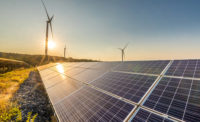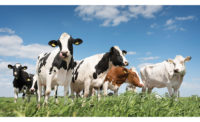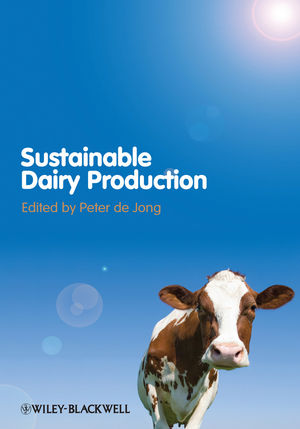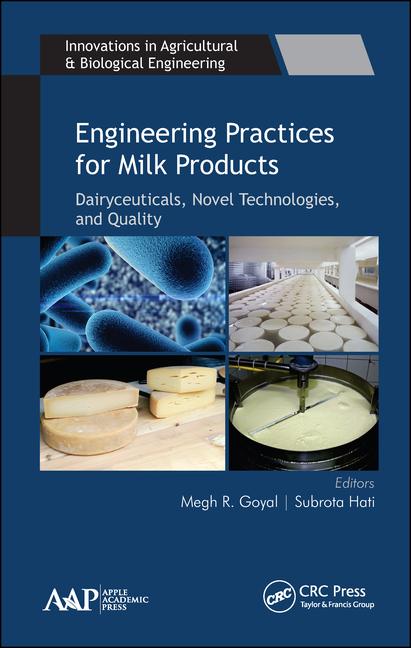Dairy processors collectively push for sustainability
Dairy companies are working collaboratively and on their own to make sustainability an industry priority.














Ask 10 people what “sustainability” means to them, and you’d probably get 10 different answers. Its dictionary definition is simple: the ability to sustain something at its current level. And dairy companies, many of which have already existed for over a century, might know a thing or two about that.
“We’ve been around for over 110-plus years, so Tillamook’s stewardship journey started more than a century ago,” says Paul Snyder, executive vice president, stewardship, Tillamook County Creamery Association, Tillamook, Ore. “As a dairy co-op, our farmer-owners have and will continue to be on the front line, focused on taking care of the land and their cows. As a business, our goal is to become both bigger and better, and sustainability plays a major role in that.”
Though sustainability is often associated only with environmental initiatives, the United Nations Brundtland Commission defined the term “sustainable development” in 1987 as “meeting the needs of the present without compromising the ability of future generations to meet their own needs.”
And for the dairy industry, a commonly understood definition is “good for people, the planet and community,” explains Lisa Watson, social responsibility officer, Innovation Center for U.S. Dairy, Rosemont, Ill., an organization formed by dairy farmers through their checkoff dollars that brings the dairy industry together to align on strategic priorities.
“The Innovation Center views dairy sustainability as an economically viable industry that provides healthy foods for people; takes good care of its animals, workers [and] resources (air, land and water); and gives back to the community,” she adds.
Consumer (mis)understanding
While many consumers are interested in sustainability, Melissa Mattilio, senior consumer marketing manager for Conestoga, Pa.-based Turkey Hill Dairy, says they do not necessarily align their purchasing choices around the issue. However, there is some evidence that this may be changing.
“A 2019 report published by NYU Stern’s Center for Sustainable Business reported that products marketed as sustainable grew 5.6 times faster than those that were not between 2013 to 2018,” she says. “Millennials, specifically, place more significance on how a product is made and the sustainability efforts of brands.”
A 2018 Nielsen study also suggested that consumer concern around the topic is growing, notes Duane Naluai, president of consumer products for Seattle-based Darigold Inc.
“[The study] found that 81% of global consumers said that it’s very or extremely important that companies implement programs to help the environment,” he notes.
Snyder concurs that sustainability is becoming a main purchase-driver for certain consumers.
“That means when it comes to products, especially in the food space, consumers are looking holistically at a brand’s approach to sustainable practices — from environmental resource management, to processes and facilities, to ingredients and packaging,” he explains.
While more consumers are considering sustainability, there are misconceptions about what is and what is not sustainable, many of which affect dairy. George Crave, president of Waterloo, Wis.-based Crave Brothers Farmstead Cheese LLC, points to “recycled misinformation” about the carbon footprint of animal agriculture that continues to be quoted in the media.
According to Kristel Corson, vice president of sales and marketing for Petaluma, Calif.-based Clover Sonoma, part of that misinformation comes from the “plant-based realm,” which often says dairy is one of the largest sources of greenhouse gas (GHG) emissions. In reality, animal agriculture adds only 9% to the U.S. carbon inventory, and dairy contributes to only 1% of that.
“Cows have definitely gotten a bad rap as far as climate change over the past decade or so,” says Britt Lundgren, director of organic and sustainable agriculture at Stonyfield Organic, Londonderry, N.H. “But I think brands like Stonyfield, Organic Valley and others are showing that dairy farming can be done responsibly, in a way that is better for the animals, the planet and consumers.”
For its part, Darigold hopes to fight consumer misinformation through its blog, “The Daily Churn,” says Naluai. The company hired an environmental journalist to cover stories relevant to the industry, including ones about sustainability.
For a recent story, Darigold interviewed Frank Mitloehner, Ph.D. — an air quality expert — about the often-quoted information in the 2006 United Nations Food and Agriculture Organization’s “Livestock’s Long Shadow” report. The publication falsely claimed that “that livestock contributed more greenhouse gas than the entire transportation sector,” notes Naluai.
“In Dr. Mitloehner’s testimony last year to the Senate Committee on Agriculture, Nutrition and Forestry, he shared that due to advances in animal care, feed and genetics, since the 1950s, U.S. dairy farms have already reduced their carbon emissions by two-thirds,” continues Naluai. “We believe that we need to help consumers understand that dairy can be a part of the solution, as it has had an impressive multi-decade decrease in carbon emissions.”
Lundgren says taking an active approach to advertising sustainability efforts can be a boon for dairy.
“We are seeing it firsthand in the positive response to our sustainability messaging and how consumers are seeking out our products,” she notes. “Our packaging has always been a very tangible place we share our commitment to better environmental and sourcing practices, and we know it’s one of the reasons consumers choose Stonyfield over other brands.”
A joint effort
To combat consumer misconceptions, the dairy industry should work together to convey accurately what it is doing to be more sustainable, says Watson. The Innovation Center, as a united voice for American dairy, publishes a biennial “U.S. Dairy Sustainability Report” (https://bit.ly/3hgqU25) that details efforts made by the industry.
The dairy community also established the U.S. Dairy Stewardship Commitment, Watson notes, a voluntary pledge in which companies agreed to measure and report on sustainability efforts.
“The industry documents and demonstrates its collective social responsibility progress in areas such as animal care, environmental stewardship, product traceability and community contributions,” she continues. “Cooperatives and processors that adopt the Stewardship Commitment agree to use consistent reporting metrics and tools, allowing U.S. dairy to aggregate information and effectively showcase its collective sustainability progress.”
Currently, 28 companies that represent 68% of milk production in the United States have taken on the U.S. Dairy Stewardship Commitment, says Naluai.
“Darigold and the Northwest Dairy Association are founding members and signatories of the U.S. Dairy Stewardship Commitment, which affirms our multigenerational stewardship principles to protect and take care of our communities, animals and the environment,” he adds.
Tillamook also is one of the participating companies, Synder confirms. Its board of directors adopted an additional internal stewardship charter in 2017.
“We release an annual Stewardship Report that describes the progress we have made toward our goals and areas of improvement,” he continues. “We’re confident that this helps address questions our fans may have about sustainability and stewardship at Tillamook.”
Leprino Foods Co., Denver, another participant in the U.S. Dairy Stewardship Commitment, is taking an even more active role in the task force. Its president, Mike Durkin, is the chairman.
“As a member of this task force, our company is working hard to align the majority of U.S. dairy processors to the Innovation Center’s Stewardship Commitment and [is] doing our part to keep the industry as a whole moving down a common path,” notes Adam Wylie, Leprino Foods’ associate director, environment and global responsibility. “At Leprino Foods, we aim to reduce the resource intensity and impacts of our operations while maintaining the highest standards of quality, food safety and environmental compliance.”
Renewable energy and more
One specific way that some dairy processors are becoming more sustainable is by using renewable energy instead of GHG to power their operations.
Tillamook, for example, switched its visitor center to 100% renewable energy last year, says Snyder.
“We also reduced [carbon dioxide equivalent] emissions by 44,000 metric tons in 2019, which is the equivalent of taking 9,506 passenger vehicles off the road,” he continues.
Crave Brothers powers all of its plant operations on renewable energy, explains Crave, along with its farm. It does this using an anaerobic digestion system. Through a biodigester, the cheese company turns organic waste into natural biogas that can be used as an energy source. The system also generates enough extra electricity to power 300 local homes.
For its part, Organic Valley recently completed a climate action plan, notes Nicole Rakobitsch, sustainability manager, which formalizes the cooperative’s “climate work to date and creates a framework to build on that work.” Additionally, the La Farge, Wis.-based processor reached the goal of 100% renewable power in its offices and in the production facilities that it owns last year.
Turkey Hill also finished the switch to 100% renewable energy at its Conestoga plant in 2019, says Mattilio. The facility’s energy is derived from “nearby hydroelectric dams and two wind turbines.”
The company actually won the “Outstanding Supply Chain Collaboration” at the Innovation Center for U.S. Dairy’s 2020 Sustainability Awards for another one of its initiatives: a clean water partnership with the Alliance for the Chesapeake Bay and the Maryland & Virginia Milk Producers Cooperative, adds Mattilio.
Through the partnership, the companies “will take momentous strides toward cleaning up local water quality in the Lancaster, Pa., area by providing incentives for local dairy farmers to use a conservation plan on their property,” The Alliance for the Chesapeake Bay notes on its website.
Leprino was another winner at the 2020 Sustainability Awards. The company won the “Outstanding Dairy Processing and Manufacturing” award for its Greeley, Colo., plant.
“Starting as a brownfield site, the former home of a sugar-processing factory, we are truly proud of the state-of-the-art facility we have built,” remarks Wylie. “Employees at the plant, and throughout the company, have been instrumental in the successful deployment of cutting-edge technology that [has] made measurable and beneficial progress on reducing our impact on the environment.”
The plant’s innovative processes include a heat/power system that provides 75% of the plant’s energy needs, a wastewater solids digester and biogas cogeneration engine, a plantwide LED lighting upgrade, and an internal water reclamation/purification system that results in “an additional 600,000 gallons of clean water that is returned to the local river daily, which is enough to sustain approximately 2,000 households,” Wylie notes. Leprino hopes to implement some of the initiatives from the Greeley plant across more of its production facilities.
And Albert Straus, founder/CEO of Straus Family Creamery, recently forged a partnership with BMW Group and the Straus Dairy Farm through California’s Low Carbon Fuel Standards (LCFS) program. (The Straus Dairy Farm is one of 12 farms that supplies milk to Petaluma, Calif.-based Straus Family Creamery.)
According to Straus Family Creamery, the partnership with BMW “will make low-carbon charging available for BMW’s electric vehicle customers in California, converting methane produced from cow manure into biogas.”
“The LCFS program helps meet the urgent need to decrease greenhouse gas emissions in both the transportation and farming sectors, allowing dairy farmers access to a new revenue stream while achieving emission-reduction goals required by California law,” the company says. “Under the LCFS program, producers of fossil fuels used for California transportation must trade credits from low carbon fuel makers, thereby subsidizing the cost of producing low-carbon fuels and incentivizing their expansion.”
On the farm
Many dairy processors with which Dairy Foods spoke are looking at their milk sources to improve sustainability. Some cooperatives are working directly with their farmer-members to make changes, and other companies are developing programs for farmers or incentivizing sustainable processes through higher payment.
Organic Valley, for example, offers the Climate Smart Farming program to the farmers in its cooperative.
“We provide technical and grant-writing assistance to help our farmers implement on-farm projects, which improve the [environmental] sustainability of their farms,” Rakobitsch says.
The cooperative also is in the process of completing a life cycle assessment of its milk supply, she says. The work will help Organic Valley come up with focus points for its Climate Smart Farming program, including identifying which regions of the United States it can have the most impact.
Tillamook also works with the members of its cooperative on sustainability efforts, explains Snyder.
“On our farms, we strive for closed-loop systems, where a dairy farmer recycles all nutrients and organic matter back into the soil that it grew in,” he adds. “A great example of this is Threemile Canyon Farms, one of our milk suppliers for over 20 years based in Boardman, Ore. They’ve successfully implemented a closed-loop system to turn farm waste into renewable energy.”
The farm also was a winner at the 2020 U.S. Dairy Sustainability Awards in the “Outstanding Dairy Farm Sustainability” category.
For its part, Stonyfield developed the “OpenTEAM initiative,” a farmer-operated suite of technologies that provides information to help farmers with soil issues. By improving soil health, farmers can “increase carbon sequestration in soil,” explains Lundgren, which would decrease GHG emissions.
“Organic farmers, who already focus on soil health, are uniquely well-positioned to help create a future where agriculture is a net sink, instead of a net source, of GHG emissions,” says Lundgren.
Thinking of people, too
Sustainability isn’t just about the environment; it’s also about people, notes Crave. For example, Crave Brothers is installing new equipment to make its employees more productive.
“Automation is definitely a way be more efficient, sustainable and long-term,” says Crave, adding that looking at new forms of technology is critical to the “continuous improvement” idea that is central to Crave Brother’s view of sustainability.
Lundgren says sustainability in the dairy industry cannot be achieved without helping the people behind the milk source: dairy farmers. Stonyfield is especially concerned about the rate at which small and medium-sized farms are disappearing.
“Today, the average age of dairy farmers in the Northeast and across the country is approaching, or exceeding, 60 years old,” she remarks. “Stonyfield is helping turn this around, particularly since we’re aware that the challenges are even greater for young organic dairy farmers that are just starting out.”
Expansive future goals
While many U.S. dairy companies already are taking great steps to be sustainable, there is always room for improvement, notes Colson. Clover Sonoma recently completed an overall emissions analysis so it can understand its emissions hot spots and work to improve in those areas.
“Sustainability is a journey,” she says. “You can’t just check off a couple of things and say you’re good.”
For its part, Stonyfield set a goal, approved by third-party Science Based Targets initiative, “to reduce its carbon output by a target of 30% by the year 2030,” Lundgren notes.
“This is aligned with the Paris Agreement’s broader goals to limit global warming to less than 2 degrees Celsius and cut global greenhouse gas emissions by 49% to 72% from 2010 levels by 2050,” she adds. “In addition to the agriculture sector, Stonyfield Organic’s carbon-reduction efforts will also focus on the areas of energy, waste, packaging and logistics.”
And Watson says the Innovation Center is adopting even bigger goals for the next few decades. After a yearlong process that included a third-party assessment, it announced its 2050 goals this March. They include becoming carbon-neutral or better, enhancing water use while maximizing recycling, and improving water quality by optimizing the utilization of manure and nutrients.
“These goals will help the dairy industry build upon and quantify collective progress toward its vision to be an environmental solution,” explains Watson. “Progress against the goals will be reported in aggregate every five years beginning in 2025, with the U.S. Dairy Stewardship Commitment metrics serving as the foundation for providing meaningful markers of progress.”
Darigold is one of the companies that will be participating in the 2050 goal for carbon neutrality.
“Reaching that goal will require a mix of strategies across our enterprise,” says Naluai. “On our member-owner farms, we are already seeing a greater focus on carbon-sequestration strategies along with methane mitigation strategies through innovations in feed, biological systems and renewable energy projects.”
Looking for a reprint of this article?
From high-res PDFs to custom plaques, order your copy today!







.jpg?height=200&t=1639062115&width=200)









